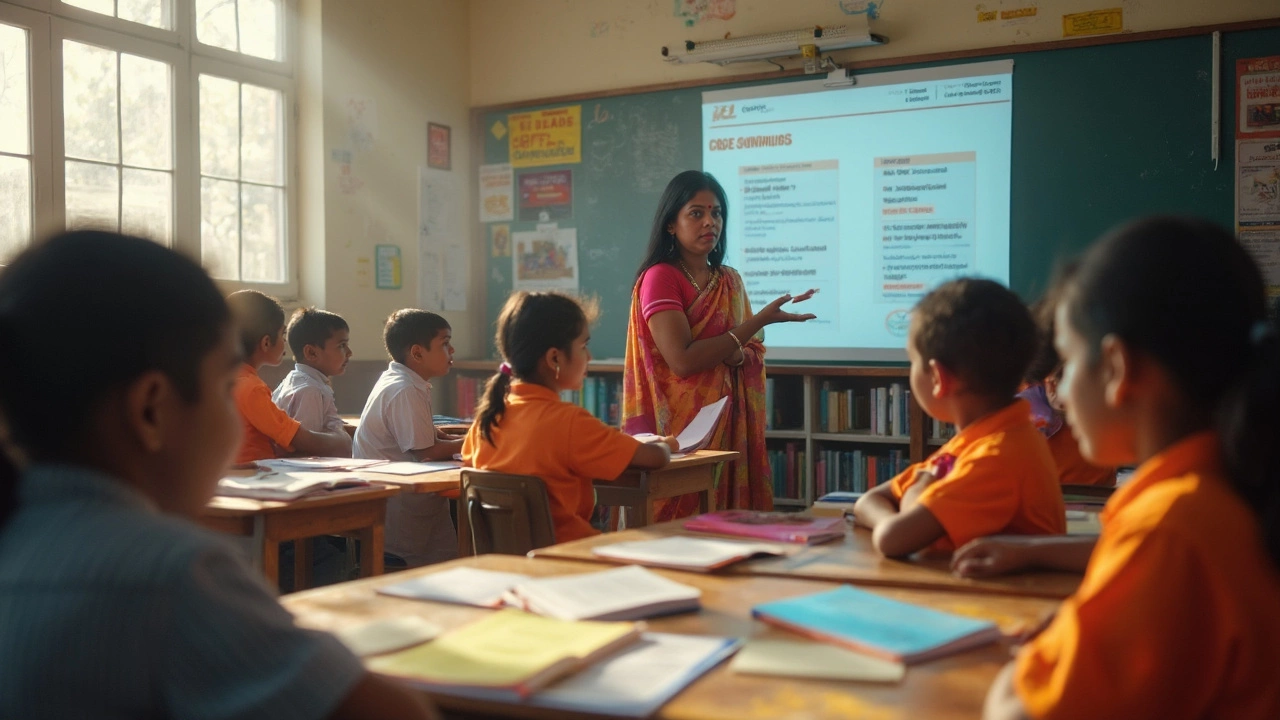Ever looked at your kid’s school bag and wondered what’s actually inside all those textbooks? The CBSE syllabus is the real backbone behind what millions of kids study in Indian schools. If you’ve heard teachers, school WhatsApp groups, and anxious parents tossing around the phrase “CBSE syllabus” and still felt lost—it’s not just you.
CBSE stands for Central Board of Secondary Education, and its syllabus is set by experts and tweaked pretty much every year. It decides what’s taught in every class from basics in Class 1 all the way up to complicated stuff in Class 12. So, whether you’re a parent, a student, or honestly just someone curious about how Indian schools work, knowing what’s inside this syllabus makes a huge difference—especially when those board exam months creep up.
The most useful thing to know? The CBSE syllabus doesn’t just say “study maths or science”—it tells you the topics, project ideas, the test pattern, which bits are important, and even what’s been dropped that year. And here’s a small secret: if you’re aiming for medical or engineering entrance exams, the CBSE syllabus lines up pretty closely. So paying attention now means fewer surprises later.
- What Exactly Is the CBSE Syllabus?
- Structure and Key Subjects by Grade
- Why the Syllabus Changes Yearly
- Tips for Students and Parents Using the CBSE Syllabus
What Exactly Is the CBSE Syllabus?
Think of the CBSE syllabus as the official instruction manual for schools following the Central Board of Secondary Education in India. It spells out the subjects, units, chapters, assignments, project work, and even the exam style for every grade. The CBSE board sends out a fresh, detailed syllabus guide every academic year—sometimes with big changes and sometimes just little tweaks. If your child is in a CBSE school, literally everything—from classroom lessons to homework assignments and board exam prep—comes from this officially released syllabus.
One thing that makes the CBSE syllabus unique is its wide reach. About 25,000+ schools in India and abroad follow it. Textbooks by NCERT (that’s National Council of Educational Research and Training, in case you’ve wondered) are usually matched up with the CBSE plan to keep things uniform for students from Delhi to Dubai. And it’s not just about rote memorization—projects, practicals, open book assessments, and real-world exercises are all part of the deal now.
If you look at a syllabus document, it’s broken down like this:
- List of subjects offered per grade (like Maths, Science, English, Social Science, etc.).
- Topics and sub-topics under each subject.
- Mark distribution for final exams and internal assessments.
- Project or lab work details (especially from Class 9 onwards).
- Recommended textbooks and extra readings.
To give you a clear idea, here’s a simplified snapshot for core subjects in CBSE Classes 10 and 12 as it was set for 2024-25:
| Subject | Key Topics | Internal Assessment (%) | Final Exam Marks (%) |
|---|---|---|---|
| Maths (Class 10) | Algebra, Geometry, Trigonometry, Statistics | 20 | 80 |
| Science (Class 10) | Chemistry, Biology, Physics, Practical Work | 20 | 80 |
| English (Class 12) | Literature, Reading, Writing Skills | 20 | 80 |
| Physics (Class 12) | Electrostatics, Optics, Modern Physics, Lab Sessions | 30 | 70 |
The CBSE syllabus is publicly available on the board’s official website. Schools usually upload it to their portals too. If your kid’s textbook topics aren’t matching up, it’s best to double-check with the latest CBSE release. Staying updated helps avoid syllabus “surprises,” especially when CBSE drops or adds entire chapters in certain years (looking at you, pandemic years!).
Structure and Key Subjects by Grade
Let’s break down how the CBSE syllabus is built across different classes. If you’re lost in all the book lists and subject combos, you’re not alone—this is the part where most parents start Googling like crazy.
CBSE keeps things pretty structured, but it actually looks a bit different depending on where your kid is in school.
- Classes 1-5 (Primary): Kids focus on basics—English, Hindi, Maths, Environmental Studies (EVS), and sometimes a third language. No crazy pressure here, but these years quietly set up all future learning.
- Classes 6-8 (Middle School): Now science splits into Physics, Chemistry, and Biology units (still within “Science”). Social Studies turns into History, Geography, Civics. English and Hindi continue, plus a third language (could be Sanskrit, French, or a regional Indian language). Maths gets more detailed, and projects and practicals start getting counted.
- Classes 9-10 (Secondary): Serious business. Science and Social Science as main buckets (each with those split topics). English stays important. Students choose one other language. You’ll also see subjects like Information Technology and Foundation of IT as options in many schools. Board exams at the end of Class 10 are based on this exact syllabus.
- Classes 11-12 (Senior Secondary): It's stream time—students pick Science, Commerce, or Humanities/Arts. Here’s how it usually splits:
| Stream | Core Subjects |
|---|---|
| Science | Physics, Chemistry, Maths/Biology, English, optional subject (like Computer Science, Physical Education) |
| Commerce | Accountancy, Business Studies, Economics, English, optional subject (like Maths, Informatics Practices) |
| Humanities/Arts | History, Geography, Political Science, English, optional subject (like Psychology, Fine Arts, Sociology) |
Each of these streams comes with detailed chapters, lab work, and even field projects—depending on the subject. Every year, CBSE releases a fresh syllabus document (called ‘curriculum’) that lists everything: topics, chapter weightage, project guidelines, and deleted portions (stuff not asked in the exams).
One little tip: Pay attention to those “deleted portions” updates each year—many students (and teachers) miss them, and it can mean studying extra stuff that won’t even be on the board exam.

Why the Syllabus Changes Yearly
Most parents think the CBSE syllabus is set in stone, but the truth is, it’s more like your phone’s software—always updating for a reason. The board tweaks the content every year, and sometimes by a lot. Why? The world moves fast, and what was relevant five years back might sound ancient today. The big goal is to keep what students learn in school matched up with real-world trends, tech, and global events.
Take the shift to digital tools and coding. Ten years ago, computer science meant some typing and basic paint. Now, there’s coding, logical reasoning, even cyber safety added to the mix. And, after the COVID-19 pandemic, CBSE added health, hygiene, and mental wellness topics—straight into official textbooks. Here’s another one: in 2023, CBSE cut about 30% of the syllabus for Classes 9 to 12 to reduce stress and help students catch up post-pandemic. That’s not a small change—it gave kids and teachers space to focus on core ideas instead of memorizing everything.
The board also consults top universities and industry experts, especially for classes 11 and 12, so the jump from school to college isn’t so harsh. They track what’s happening in IIT and medical entrance exams too, so the CBSE syllabus lines up and actually preps students for bigger tests.
Want to see some recent changes in numbers? Check out this quick table:
| Year | Major Change | Affected Classes |
|---|---|---|
| 2020-21 | Online learning topics added | All |
| 2021-22 | Mental health & safety chapters included | 6-12 |
| 2023-24 | 30% reduction in content to reduce stress | 9-12 |
| 2024-25 | Skill subjects and coding expanded | 6-12 |
So, the next time your kid’s booklist is different or something new pops up in the curriculum, it’s probably happened for a good reason. Staying updated pays off—especially when it comes to exams and the stuff that actually matters after school.
Tips for Students and Parents Using the CBSE Syllabus
If you look at the CBSE syllabus as just a stack of topics to get through, you’re missing a trick. It’s actually the best roadmap for surviving the term and nailing board exams. Here’s how to make the most of it without losing your mind (or your sleep!).
- Start With the Latest Syllabus PDF: Every year, the CBSE website posts updated syllabus PDFs for each class and subject. It’s not a waste of time to check if your teacher is following the latest one—sometimes even classes and tuitions are using last year’s copy.
- Pay Attention to Deleted Topics: CBSE sometimes drops chunks of the syllabus (especially after disruptions, like the pandemic). Don’t waste time studying stuff that’s not going to be tested this year. You’ll usually find a "deleted topics" notification on CBSE’s site.
- Use the Official Sample Papers: CBSE releases its own sample papers every year. These show the kind of questions you’re likely to get and the marking scheme too. Practicing these means you’re not caught off guard on exam day.
- Break It Down Into Weekly Targets: Rather than panicking before exams, break the syllabus up into weekly chunks. Stick a tracker on the fridge; it keeps you focused and it feels good to tick things off (even Clara, my spouse, swears by this trick for our niece).
- Project Work and Internal Assessments Matter: For most subjects, about 20% of your marks come from project work and internal assessments. Read the syllabus for what’s actually required. Some kids ignore this part and lose easy marks.
- Keep an Eye on Language Requirements: In primary classes, kids learn two or even three languages—Hindi, English, and another local language. By secondary, you might have the option to choose which languages to continue. It’s all listed in the syllabus by grade.
Here’s a quick look at how CBSE marks and internal assessments usually break up by major subjects:
| Subject | Board Exam Marks | Internal Assessment/Project |
|---|---|---|
| Maths | 80 | 20 |
| Science | 80 | 20 |
| Social Science | 80 | 20 |
| English | 80 | 20 |
Last tip: Don’t treat the syllabus like some giant mystery. Download it, print it, and put it on the study table. It’ll keep everyone focused—students and parents—right to the last exam.
